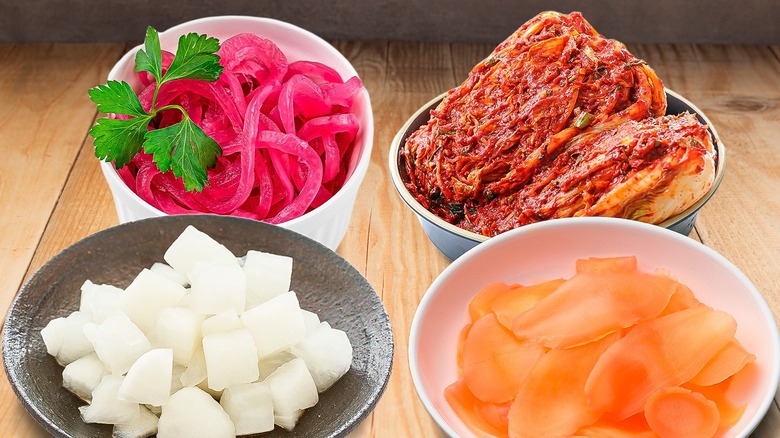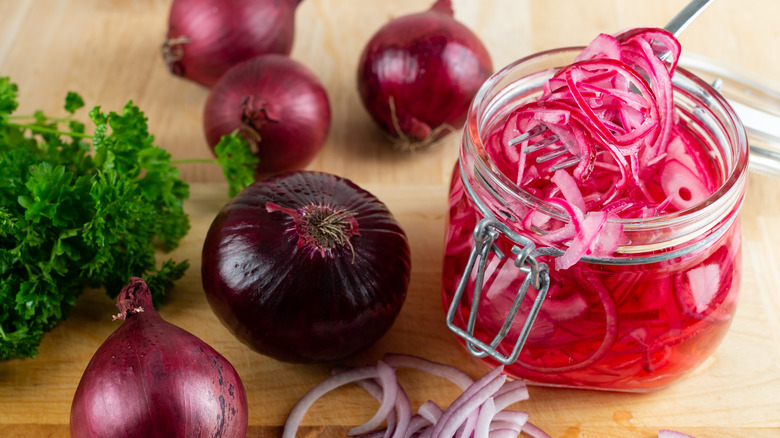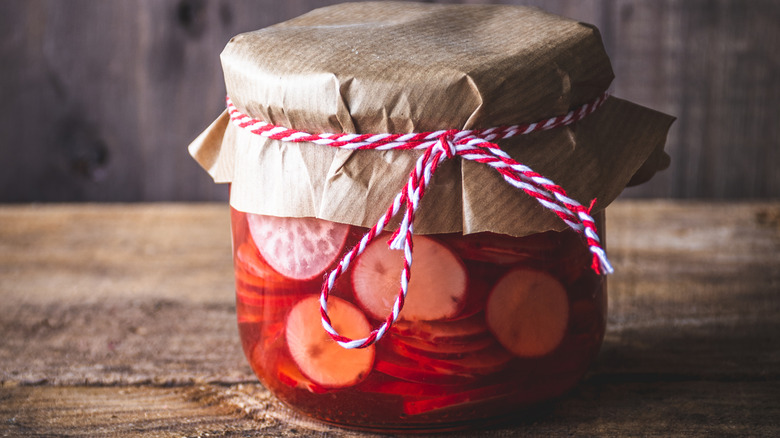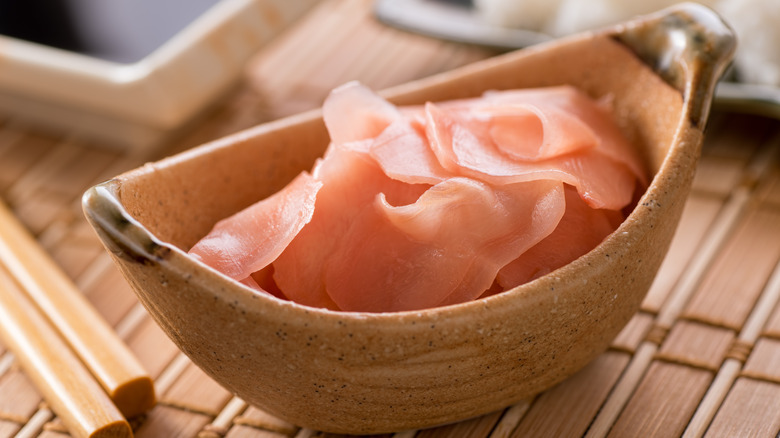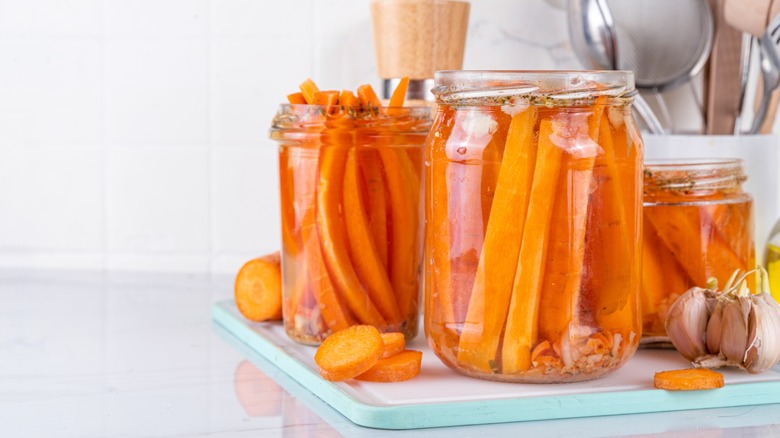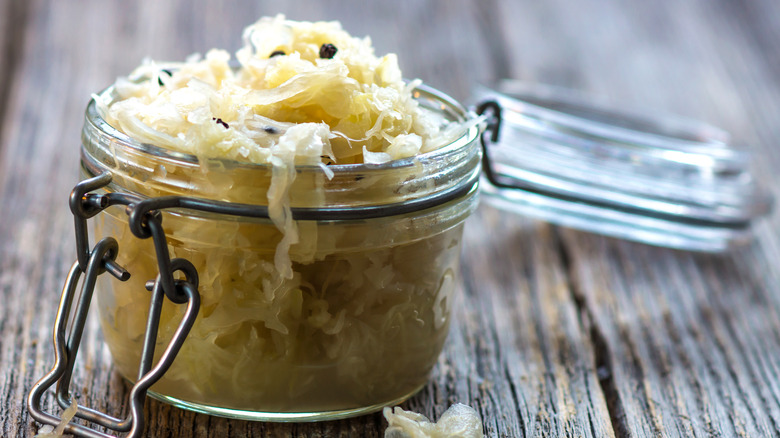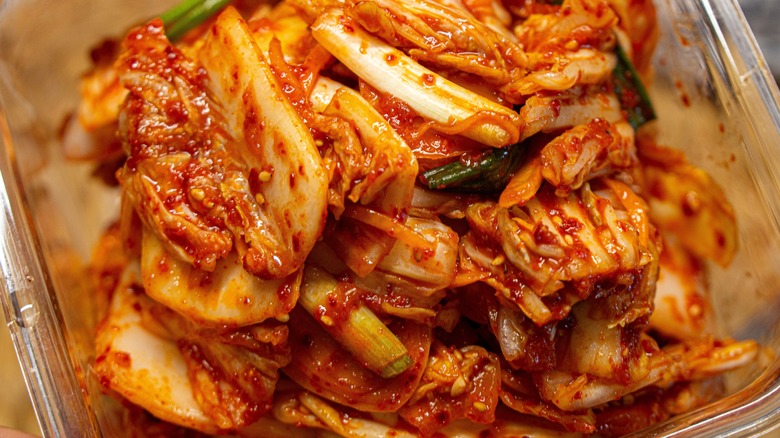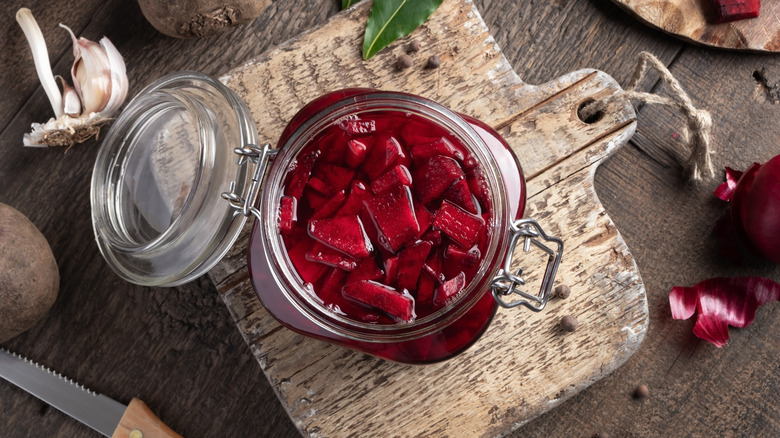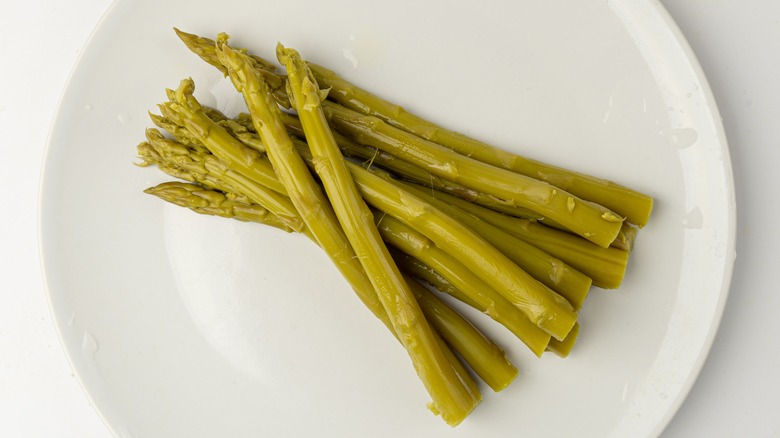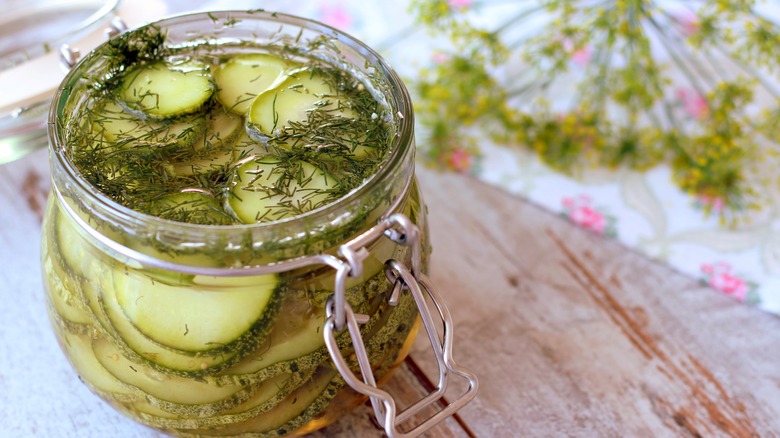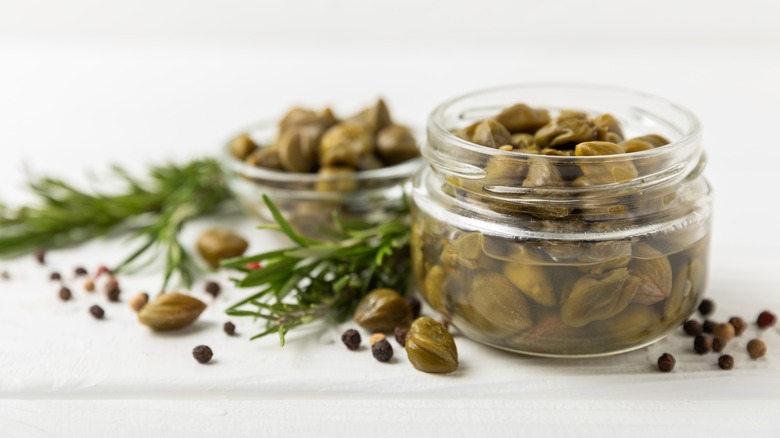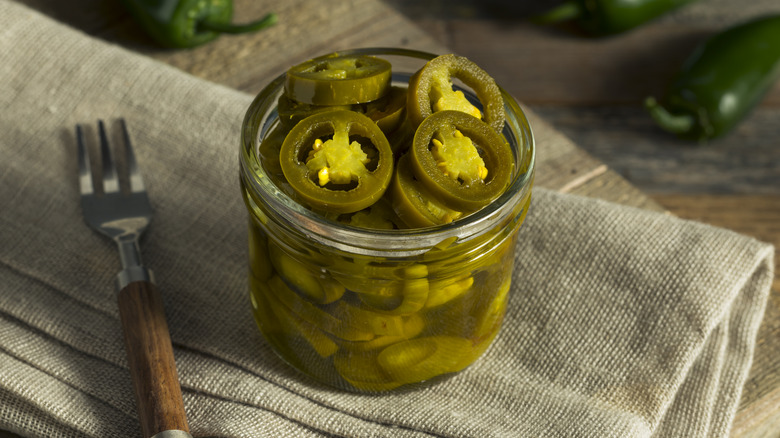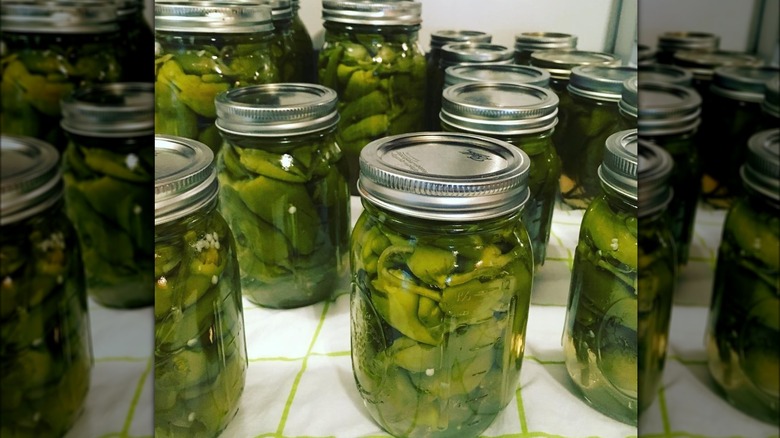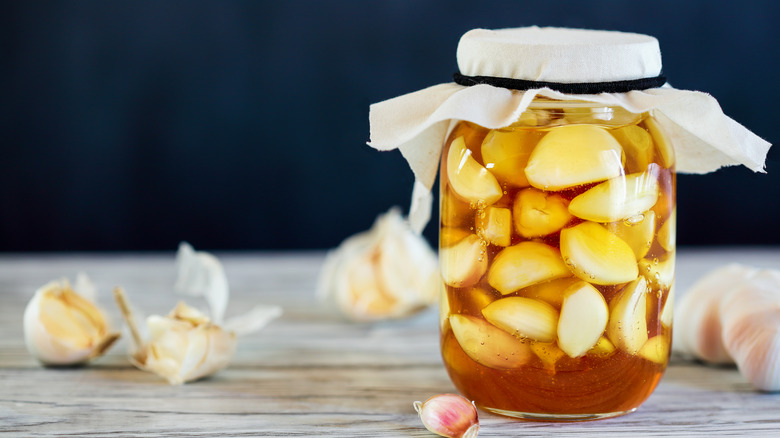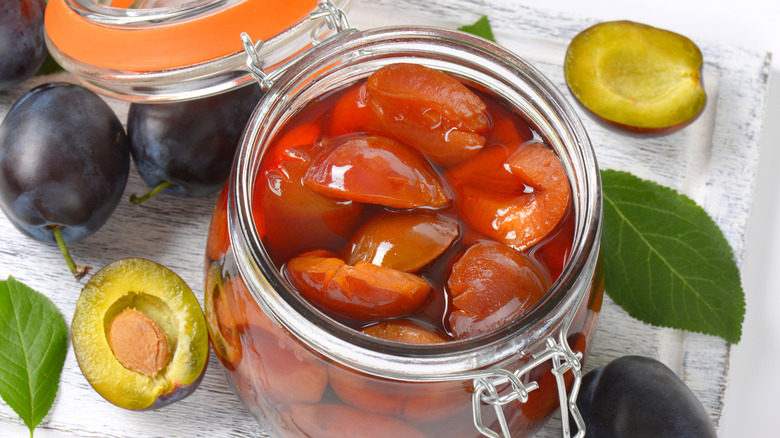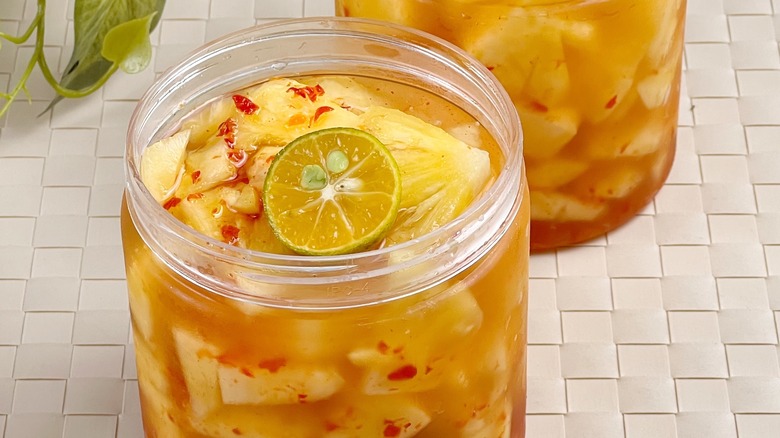The Best Pickle Substitutes For Any Recipe
Whether they're being used to top a juicy burger, diced up to make a sauce, or simply snacked on straight from the jar, pickles are something we frequently reach for in the kitchen. They're readily available, last for a pretty substantial length of time in the fridge, and with their tangy and flavorful crunch, pickles make a wonderful addition to a huge range of dishes.
When we use the term "pickles," most of our minds immediately jump to the classic green pickled cucumbers. However, this isn't the only vegetable that lends itself well to pickling. There are in fact a wide array of pickled vegetables, and even fruits, that can easily stand in for traditional pickles, with each bringing its unique characteristics to the table. So, if you're not a fan of the classic cucumber, or simply want to switch things up, we have a selection of tasty options for you to try. From the zesty zing of pickled onions to the sweet-tart goodness of pickled plums, these alternatives can add flavor and freshness to your meals in unexpected yet totally delicious ways.
Pickled onions
Pickled onions — another popular pickled veggie that makes a super versatile addition to a variety of dishes. They're slightly sweet, deliciously tangy, and guaranteed to bring a refreshing bite to your plate. You can buy pickled onions in many grocery stores, but it's also easy to make these tasty pickled veggies yourself at home. Pickled onions typically come in two popular forms — thinly sliced, red onions or whole, small white onions. The sliced red onions are fantastic for adding to burgers, tacos, or salads, whilst the white onions make a great addition to cheese boards or sandwiches.
The base for any pickling recipe tends to consist of the following — vinegar, sugar, and salt. Water is sometimes added, too. This is the brine that will preserve and flavor your veggies or fruits. It's also common to flavor the brine with some seasonings and spices of choice, such as peppercorns, coriander seeds, mustard seeds, or even garlic.
To make pickled onions, pop your whole or sliced onions in jars, heat the brine mixture in a saucepan, then pour it over the onions. Once everything has cooled to room temperature, put the lids on the jars and store them in the fridge. Whole onions will need some time to tenderize before you can enjoy them. This can take up to a month. Thinly sliced onions can be eaten much sooner, requiring just an hour of sitting in that flavorful brine before they're ready for use.
Pickled radishes
A vibrant alternative to traditional pickled cucumber, pickled radishes are great for bringing a peppery crunch to your dishes. That distinctive, bright pink color also adds a super eye-catching look. Pickled radishes are fantastic added to burgers, tacos, salads, and grain bowls. These pretty pink pickles have a mildlity spicy flavor that mellows out during the pickling process, making them slightly sweet and tangy with less bitterness than raw radishes.
To make pickled radishes, you'll need fresh radishes, your brine ingredients (vinegar, sugar, and salt), and any flavor additions of choice. Peppercorns, mustard seeds, and red pepper flakes are all great options. Slice and discard the green tops from the radishes, then thinly slice them into rounds, and pop them in a jar (or multiple jars if you're making a big batch). Heat the pickling liquid, pour it over the radishes, cool, and refrigerate. They can be enjoyed within a few hours, but develop better flavor after a day or two.
Pickled ginger
Here's one you might have already tried when tucking into a platter of sushi rolls. Pickled ginger, often associated with Japanese cuisine, is a unique and punchy substitute for traditional pickles. It has a tender yet crunchy texture, with the perfect combination of sweetness and tanginess from the pickling liquid, and natural spicy flavor from the ginger.
Though naturally pale yellow, fresh ginger will turn a subtle pink color when pickled due to the ingredients in the brine activating pigments called anthocyanins. However, to make this pinkness extra vibrant, some store-bought pickled ginger has added food coloring. If making your own pickled ginger, you can also achieve a stronger pink color by adding a radish to the pickling liquid.
When served with sushi, pickled ginger serves as a refreshing palate cleanser between bites, but its applications extend further than just in Japanese cuisine. Try adding the ginger to stir fries, or even using it as a cocktail garnish. You could also mix some of the ginger-infused brine into a dressing or marinade.
Pickled carrots
Another colorful addition to your recipes, pickled carrots are full of zingy flavor. Their vibrant orange hue looks beautiful on your plate, and their delicious natural sweetness is really highlighted during the pickling process.
To pickle carrots, you can either use small, whole carrots, or slice them into sticks, rounds, or thin ribbons. Essentially, it depends on the size of your carrots, your jars, and how you intend to serve these pickled treats. Once the carrots are in the jars, heat water, vinegar, sugar, and salt in a saucepan. White or apple cider vinegar will work great here. Then, pour the warm brine over the carrots to completely submerge them. Once cooled to room temperature, store your pickled carrots in the fridge and allow all of those wonderful flavors to meld together for at least 24 hours before enjoying.
Add your pickled carrots to salads, charcuterie boards, or as a side with grilled meats to add freshness and crunch. They're also fantastic served with Mexican dishes like carnitas and enchiladas.
Sauerkraut
One of the best ways to support your gut health is by regularly consuming fermented foods, and sauerkraut is a brilliant, readily available option in this category, perfect for adding to all kinds of dishes. Sauerkraut is finely sliced cabbage that has been slowly fermented to develop a distinctive tangy, slightly sour taste that's not too dissimilar from traditional pickles.
Sauerkraut is packed with beneficial probiotic bacteria, which develop naturally as the cabbage ferments. There is strong evidence that probiotics help to support a healthy gut microbiome, which is essential for not just our digestive health, but many aspects of our wellbeing. In addition, sauerkraut is an excellent source of many essential vitamins and minerals, like vitamin C, iron, and manganese.
Making your own sauerkraut is a rewarding process, and can be a much cheaper alternative than buying store-bought varieties. This involves thinly slicing cabbage, massaging it with salt, and leaving it to ferment at room temperature for at least five days. Here, we don't need to add any liquid, since the cabbage will actually form its own brine as it ferments. Once sufficiently tangy, the sauerkraut can be transferred to sterilized jars and stored in the fridge for up to six months. It's fantastic spooned on top of sausages or added to a Reuben sandwich.
Kimchi
Another delicious fermented food that would make a fantastic replacement for standard pickles is kimchi. Like sauerkraut, kimchi is also made with cabbage, though this is typically a variety called napa cabbage. A traditional Korean dish, it's also flavored differently to sauerkraut, with spicy and umami-rich Asian-inspired ingredients.
Kimchi also has a unique preparation process. First, the napa cabbage is rubbed with salt, before soaking in salt water. The cabbage can be thinly sliced, but it's often left in larger chunks. Next, it's rinsed, drained, and slathered with a spicy, flavorful paste, which features ingredients like chili, fish sauce, and fermented shrimp, and is often thickened with glutinous rice flour. Now, the cabbage can be transferred to a jar and left to ferment for 24 hours, before moving to the fridge.
This fiery fermented cabbage is a versatile condiment, that works wonderfully where you might typically opt for pickles. Try it in wraps, sandwiches, and burgers, as a simple side with your grilled meats and fish, or as a tangy garnish for fried rice dishes.
Pickled beets
If you want to add some rich red color to your plate, look no further than pickled beets. These delicious root veggies have a unique sweet and earthy flavor that pairs well with a range of other foods. They also have a lovely texture, that strikes the perfect balance between being tender, yet providing some appealing bite.
To make pickled beets, you'll first need to grab some fresh beets and slice away the stems. Then, boil them in a pan of water until tender and let them cool. You could also roast them in the oven if desired. Once the beets are comfortable to handle, peel off the skins. It's up to you whether you keep the beets whole or slice them into wedges or rounds. Once you've prepped them, place them into sterilized jars and add the pickling liquid. Some spices and seasonings that work fantastically with beets include cloves, mace, red pepper flakes, and bay leaves. After they've cooled, seal and refrigerate the jars. If you can resist the temptation of tasting the pickled beets earlier, waiting around two weeks is recommended for the ultimate flavor.
Another easier alternative to the slow pickling method is simply tossing freshly cooked and sliced beets in a mixture of olive oil, ume plum vinegar, garlic, salt, and pepper. These can be served immediately, and are delicious topped with a scattering of freshly parsley.
Pickled asparagus
We know that asparagus is a super versatile vegetable, lending itself just as well to boiling or sautéing as it does to roasting or grilling. But, have you ever tried pickling this humble green veggie? Pickled asparagus can serve as a sophisticated twist on that classic pickled cucumber. It has a lovely crisp texture and slightly earthy flavor, perfect for enhancing many different dishes.
Making pickled asparagus at home is super easy. First, trim the tough ends from the asparagus stalks. Place them in jars (you may need to trim them further if they're still too long), then prepare your brine mixture and pour this over. A few sprigs of dill, some garlic cloves, and whole peppercorns are a brilliant way to flavor the brine. Once the pickled asparagus has been chilled, it's time to get creative with your serving ideas. Of course, they're fantastic incorporated into salads and sandwiches, but they also make a wonderful addition to a crudité platter, or even as a unique, crunchy topping for some avo toast!
Pickled zucchini
If you want to recreate the taste and texture of pickled cucumbers as closely as possible, but don't have this veggie on hand, pickled zucchini can be a great alternative. Like cucumber, zucchini has a naturally mild flavor and will provide that same fresh, satisfying crunch. Its ability to absorb the flavors of the brine makes it a fantastic option for pickling.
Since zucchini has a high water content, the first step in making pickled zucchini is drawing out some of the liquid. This involves placing the sliced rounds of zucchini in a bowl with some salt, and letting it chill for several hours. Many homemade pickled zucchini recipes also feature sliced onion for added flavor, which can be added at this stage. Next, drain the excess liquid from the zucchini, and place it in your sterilized jars. Then, pour over your brine, with any flavorings of choice, and leave to cool. After 24 hours in the fridge, the pickled zucchinis will be ready to enjoy.
Capers
Capers make a wonderful substitute for traditional pickles, offering a deeply briny taste and satisfying bite in a much smaller package. There are a wide variety of uses for these flavorful morsels, but what exactly are capers? Well, these little green gems are in fact flower buds from the caper bush, picked before they're fully mature. Store-bought capers most commonly come in pickled form, preserved in a brine that gives them that distinct, tangy taste.
With a salty, tangy, slightly lemony taste, capers truly pack a punch in the flavor department. You can use them whole or chopped, and they're often added to sauces and condiments to help cut through rich flavors. You can even use them to elevate an egg salad! Capers are a particularly popular pairing for seafood, such as smoked salmon, or baked sea bass. They can also be added to homemade pizzas for a briny kick, and are a common ingredient in a traditional Italian spaghetti puttanesca.
Pickled jalapeños
Love the tang of pickled cucumbers by want to amp up the spice level of your meal? Try adding pickled jalapeños. These vibrant green peppers can elevate the taste of so many recipes, bringing a bold and zesty kick.
Pickled jalapeños are incredibly easy to make at home. Just slice fresh jalapeño peppers into round, discarding the stems, and add them to a jar along with the pickling liquid. We love to add some sliced garlic to infuse the peppers with extra aromatic flavor. Once everything has cooled and been sealed in the jar, the pickled jalapeños should keep for about three months in the refrigerator.
Pickled jalapeños have a slightly milder spice level and more tender texture than their fresh counterparts, making them great for adding a subtler heat to your dishes. Try using them to top your favorite Mexican dishes like quesadillas, fajitas, or tacos. Or add them to a meaty pizza for extra heat and flavor. And, of course, like traditional pickled cucumbers, they're amazing stacked up in a burger or sandwich, too.
Pickled Padrón peppers
Padrón peppers, which get their name from the region in Spain where they're traditionally grown, are long green peppers that are fantastic for pickling. This process brings out their natural sweetness and slight nutty taste. They're another brilliant alternative to pickled cucumbers if you're looking to add a unique but comfortingly tangy flavor to a meal.
An unusual quality of these peppers is the huge variation in spice level between each one. The heat of a chili pepper is measure in Scoville units, with a greater number indicating more of a kick. But Padrón peppers can sit anywhere between 500-2500 on this scale. For reference, a jalapeño pepper has a heat level of about 4000 Scoville units. So, a Padrón won't blow your head off, but it might offer a very subtle, or more of a noticeable kick, but this is completely dependent on which pepper you bite into.
Padrón peppers are delicious stuffed with a herby cream cheese as an appetizer or part of a Spanish-inspired tapas spread. You can also use them just like traditional pickles, in salads, burgers, and on pizzas.
Pickled garlic
An undeniably popular addition to most of our cooking, garlic has a fragrant, aromatic, and totally mouth-watering flavor that a whole host of savory dishes simply wouldn't be complete without. When we combine this much-loved ingredient with a sweet and tangy brine, we get pickled garlic — an incredibly versatile and delicious take on this kitchen staple.
Pickled garlic is easy to prep, and a great way to make those cloves last for far longer in your fridge. Just peel the garlic, splitting it into the individual cloves, and add it to a jar with your brine. Adding a little dill or red pepper flakes is also a great idea to add extra spice and herby flavor. For the best results, leave everything to pickle in the fridge for three weeks before using.
There are so many ways to use this delicious condiment. Add it to a meat and cheese platter as a fresh, crunchy element, or blitz it into homemade hummus, salad dressings, or stir-fry sauces to add tang and plenty of aromatic goodness. You'll find that the flavor is slightly more mellow that you'd experience if eating a raw clove of garlic, which makes it perfect for adding to salads and sandwiches, too.
Pickled plums
Plenty of veggies are great for pickling, but what about fruits? Well, as unusual as they may sound, pickled plums can be a tasty addition to various dishes. These fruits aren't just for sweet, summery desserts; they can fit perfectly into savory dishes, too.
These vivid fruits aren't always available fresh all year round, so pickling them is a brilliant way to ensure you have a supply on hand for adding to recipes. Just slice them up, remove the stones, pop them in jars, and pour over your canning liquid. Using red wine vinegar, plenty of sugar and just a little salt in the brine works wonderfully here. You can also add some warming spices like cinnamon, cloves, and star anise.
Pickled plums are amazing for enjoying with meats like steak, pork, or duck. Or try tossing them into a fresh, leafy salad for some extra sweet-tart deliciousness. You can, of course, use them in sweet desserts, too. A simple, classic option is to serve them over a bowl of vanilla ice cream.
Pickled pineapple
We're rounding off our list with another delicious tangy pickled fruit. Pickled pineapple offers a moreish combination of juiciness, sweetness, and tanginess. This tropical twist on standard pickled cucumber can bring the burst of flavor you need to take your dish to the next level.
To make your own pickled pineapple, first dice a whole, fresh pineapple up into chunks, discarding the tough outer skin, crown, and core. Now, you can combine it with the brine. For extra flavor, we recommend adding some fresh cilantro, lime juice, and diced jalapeños into the mix.
Once everything has chilled in the fridge overnight, the pickled pineapple is ready to use. This one is particularly delicious served as a topping for Mexican-inspired dishes, like tacos or burrito bowls. Or add them to cocktails for a fresh, summery vibe. Pickled pineapple can even be used to elevate a grilled cheese sandwich, when layered between the slices of cheese with a little sriracha hot sauce.
